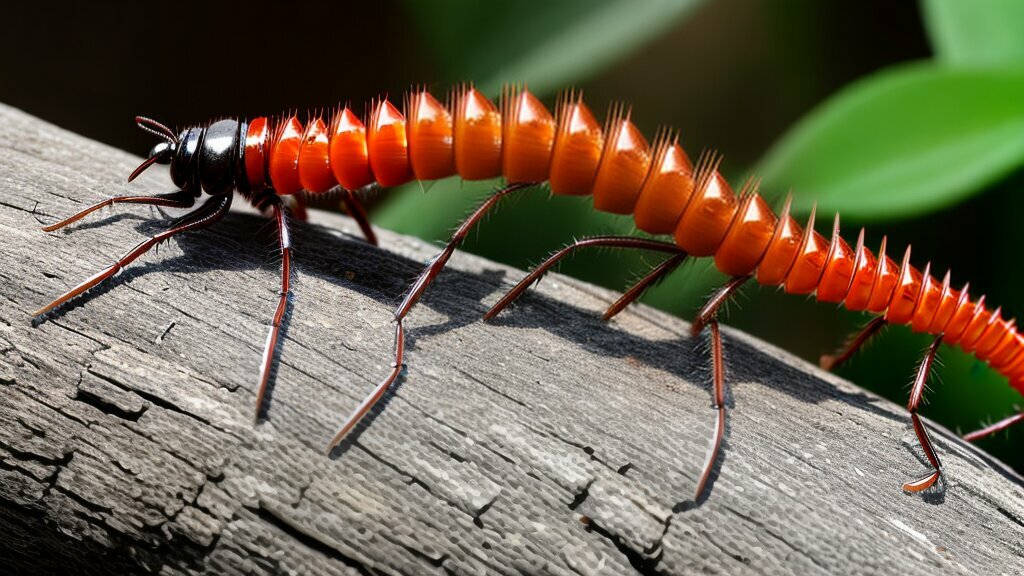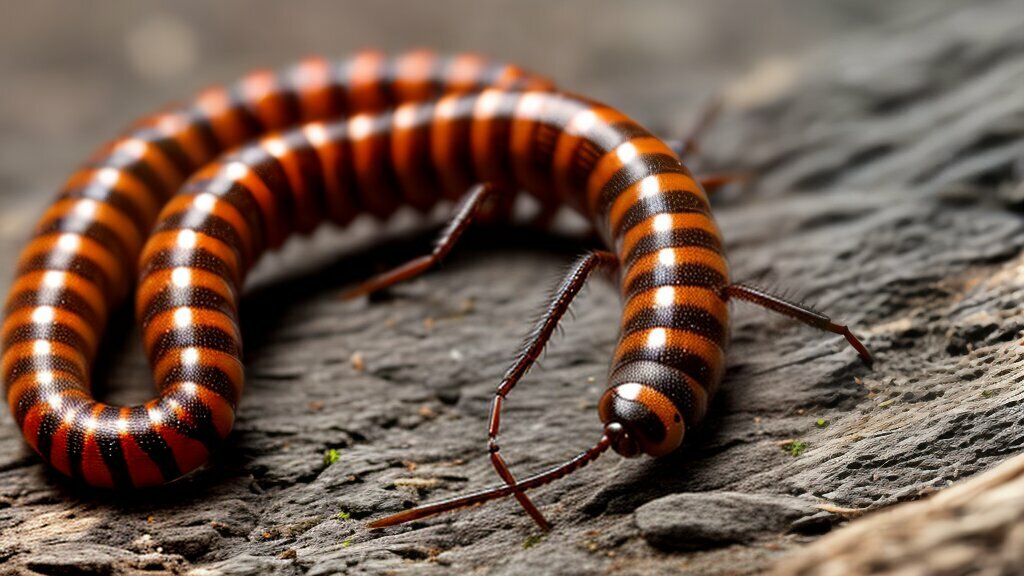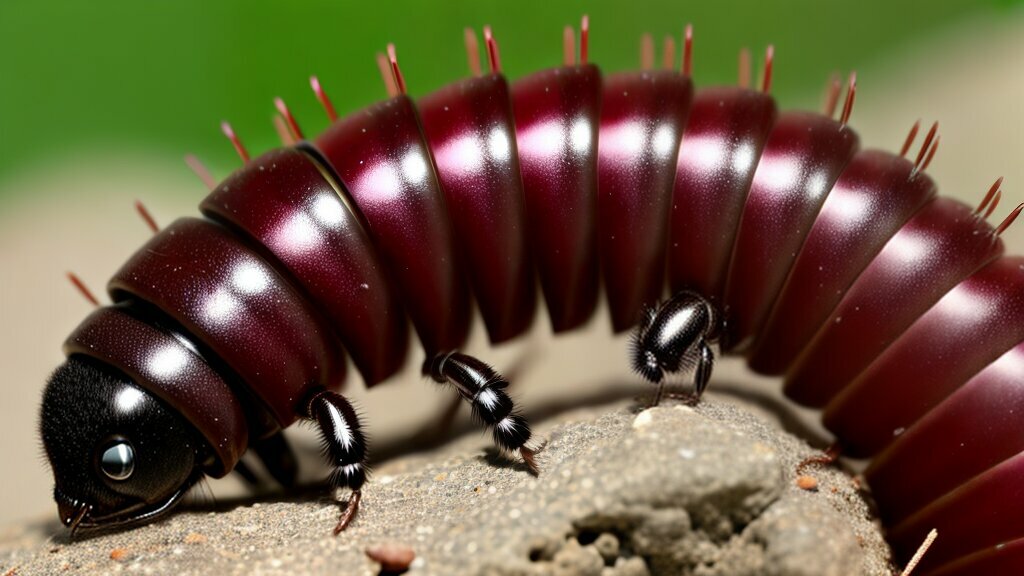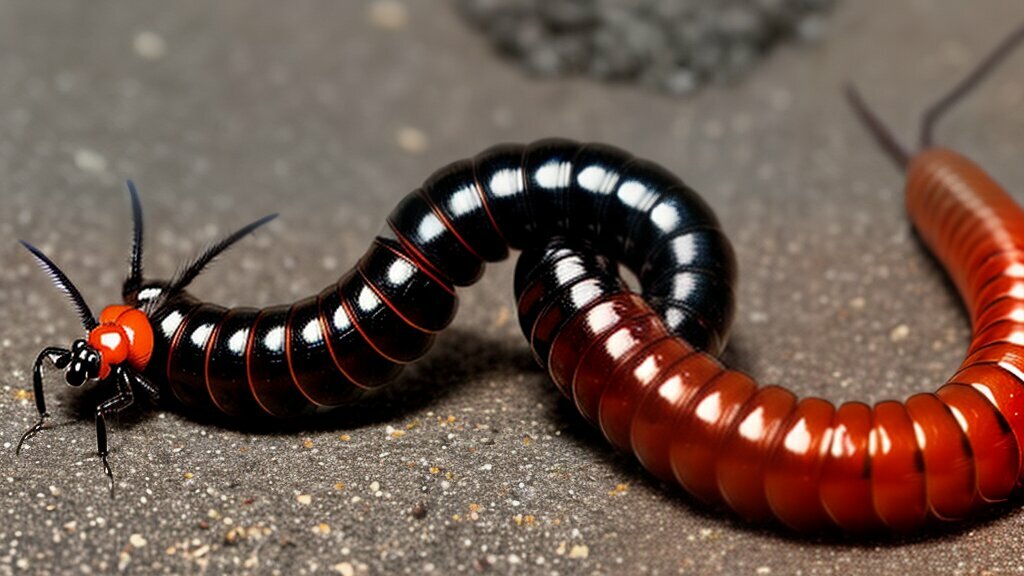Centipedes and millipedes are fascinating creatures that often provoke curiosity. However, one question that may come to mind is whether these multi-legged critters can bite. In this article, we will explore the truth about centipede and millipede bites and provide you with the knowledge to better protect yourself.
Key Takeaways:
- Centipedes and millipedes do have the ability to bite, but not all species are harmful to humans.
- Understanding the behavior and habits of centipedes and millipedes can help reduce the risk of getting bitten.
- First aid measures and medical attention may be necessary in cases of severe bites or allergic reactions.
- Preventive measures can be taken to minimize the risk of centipede and millipede bites, such as keeping them out of your home and garden.
Biting Habits of Centipedes and Millipedes
Centipedes and millipedes are not aggressive creatures, but they do bite when they feel threatened or cornered. Centipedes have venomous jaws or forcipules that they use to inject venom into their prey or potential threats. Millipedes, on the other hand, do not have venomous bites but may secrete a toxic liquid from their pores that can cause skin irritation and discoloration.
Centipedes are active hunters that mainly feed on insects, spiders, and other small invertebrates. They are most active at night and are attracted to warm, humid environments. If they feel threatened, they will use their venomous jaws to defend themselves, causing a painful and potentially dangerous bite.
Millipedes, on the other hand, are primarily detritivores and feed on decaying organic matter. They are generally harmless to humans, but some species have specialized glands that can produce defensive secretions when threatened. These secretions can cause skin irritation and discoloration, but they are not toxic enough to cause serious harm.
Biting Targets of Centipedes and Millipedes
Centipedes and millipedes will only bite humans when they are provoked or feel threatened. Centipedes tend to bite exposed skin, such as the hands or feet, while millipedes may bite any area that comes into contact with their body. In some cases, millipedes may crawl onto bed linens and other soft fabrics and bite humans during sleep.
It is important to note that bites from centipedes and millipedes are relatively rare, and most encounters with these creatures do not result in a bite. However, it is still important to exercise caution around them and take necessary precautions to avoid a bite.
Circumstances that May Trigger a Bite
Bites from centipedes and millipedes are most likely to occur in warm, humid environments such as basements, crawl spaces, and gardens. If you come across a centipede or millipede in these areas, it is best to give them space and avoid touching them. Additionally, if you are handling garden debris or other materials where these creatures may be hiding, it is best to wear gloves and protective clothing.
If you are bitten by a centipede or millipede, it is important to remain calm and seek medical attention if necessary. Most bites can be effectively treated with first aid measures, such as cleaning the wound and applying a cold compress, but severe reactions may require medical attention.
Differentiating Centipede and Millipede Bites
While both centipedes and millipedes have the ability to bite, it’s important to know the differences between their bites. By being able to differentiate between the two, individuals can take the appropriate measures to treat the bite and avoid future encounters.
Centipede Bites
| Appearance of Bite Marks | Severity of Bites | Distinguishable Symptoms |
|---|---|---|
| Bite marks are small with two puncture wounds, and may appear red and swollen | Centipede bites are usually painful but not life-threatening, with symptoms lasting up to a few days. | Individuals may experience local swelling, redness, and itching. In rare cases, allergic reactions may occur. |
Millipede Bites
| Appearance of Bite Marks | Severity of Bites | Distinguishable Symptoms |
|---|---|---|
| Bite marks may appear as a rash or reddish bumps in a line. | Millipede bites are generally not severe and typically cause only mild pain. | Individuals may experience local irritation, itching, and redness. In rare cases, an allergic reaction may occur. |
It’s important to note that if an individual experiences severe symptoms, such as difficulty breathing or a severe allergic reaction, they should seek medical attention immediately.
Signs and Symptoms of Centipede and Millipede Bites
Centipede and millipede bites can vary in severity depending on the species and the individual bitten. The symptoms may range from mild localized pain to more severe reactions, including allergic reactions. Here are some common signs and symptoms to watch out for:
- Pain: A centipede or millipede bite can cause immediate pain at the site of the bite. The pain may range from mild to intense, depending on the size and venom of the creature.
- Swelling and Redness: The bite area may become swollen and red, sometimes causing a raised bump. In some cases, the swelling may spread beyond the immediate area of the bite.
- Blisters: Blisters may form at the site of the bite, especially in severe cases. These blisters may fill with fluid and break open, leading to an increased risk of infection.
- Numbness or Tingling: Some people may experience numbness or tingling around the bite area or in other parts of the body.
- Fever: A fever may develop in more severe cases, especially if the bite has become infected.
- Allergic Reactions: Some people may experience an allergic reaction to the bite, which can cause symptoms such as difficulty breathing, swelling of the face or throat, and rapid heartbeat. Allergic reactions can be life-threatening and require immediate medical attention.
If you experience any of these symptoms after being bitten by a centipede or millipede, it is important to seek medical attention. Additionally, if the bite has become infected or shows signs of a secondary infection, such as pus or red streaks, medical treatment is necessary.
Treating Centipede and Millipede Bites
If you have been bitten by a centipede or millipede, it is essential to take action promptly. While most bites are not life-threatening, they can cause considerable discomfort and may lead to complications in some cases.
Here are some steps you can take to treat centipede and millipede bites:
- Clean the bite wound: Wash the affected area with soap and water to remove any dirt or debris. This will also help prevent infection.
- Apply a cold compress: Use a cold compress or an ice pack wrapped in a towel to reduce swelling and discomfort. Apply the compress for 15-20 minutes at a time, several times a day.
- Take pain relievers: Over-the-counter pain relievers such as acetaminophen or ibuprofen can help reduce pain and inflammation. However, avoid aspirin, as it may increase bleeding.
- Watch for signs of infection: Keep an eye on the bite wound and contact a healthcare professional if you notice any signs of infection, such as redness, warmth, swelling, or discharge.
- Seek medical attention if necessary: In rare cases, centipede or millipede bites can cause severe symptoms, including anaphylaxis (a severe allergic reaction). Seek medical attention immediately if you experience difficulty breathing, swelling of the face or throat, dizziness, or other severe symptoms.
If you have a history of severe allergic reactions, it is advisable to carry an epinephrine autoinjector (such as an EpiPen) with you at all times. This can help counteract the effects of anaphylaxis in case of a severe reaction.
Remember that centipede and millipede bites can be painful and uncomfortable, but they are rarely dangerous. By taking prompt action and following these treatment tips, you can minimize the risk of complications and make a full recovery.
Preventing Centipede and Millipede Bites
To avoid bites from centipedes and millipedes, it is important to take preventive measures both inside and outside the home. Here are some tips:
- Seal any cracks or gaps in windows, doors, and walls to prevent entry
- Remove debris, leaf litter, and woodpiles from the yard to reduce potential hiding spots for these creatures
- Keep basements, attics, and crawl spaces well-ventilated and dry to discourage infestations
- Wear protective clothing such as long sleeves and pants when working in areas where these creatures may be present, such as gardens or woodpiles
- Use insect repellent to deter centipedes and millipedes from approaching
- Regularly vacuum and clean areas where these creatures may gather, such as behind furniture and in corners of rooms
By following these preventive measures, you can significantly reduce your risk of getting bitten by centipedes and millipedes. However, if you do encounter one of these creatures and are unsure if it is harmful, it is best to give it a wide berth and contact a pest control professional for assistance.
Conclusion
Centipedes and millipedes may not be the most popular creatures, but they can still cause a stir due to their biting habits. As we have learned, not all centipedes and millipedes bite, but those that do can deliver a painful bite. By understanding their behavior and taking preventive measures, we can minimize our risk of getting bitten.
If you do experience a bite, it’s important to identify the culprit and treat the wound properly. Initially, you should clean the wound and apply a cold compress to reduce any swelling or pain. If the symptoms persist or if you experience an allergic reaction, seek medical attention immediately. Remember, prevention is key, and by taking the necessary precautions, you can keep yourself and your home safe from these creatures.
Stay Vigilant
Always be vigilant, especially when outdoors and in areas where centipedes and millipedes are known to reside. Wear protective clothing and avoid walking barefoot in such environments. Additionally, keep your surroundings clean and clutter-free to discourage these creatures from entering your home. Remember, while centipedes and millipedes may not be the most dangerous creatures, they can still cause harm if not handled properly.
FAQ
Q: Do Centipedes and Millipedes Bite?
A: In this section, we will provide an introduction to the topic and discuss whether centipedes and millipedes have the capability to bite. We will address common misconceptions and provide a clear answer to the question.
Q: Biting Habits of Centipedes and Millipedes
A: In this section, we will delve into the biting habits of centipedes and millipedes. We will explore the reasons why they bite, their preferred targets, and the circumstances that may trigger a bite. By understanding their behavior, we can gain insight into the likelihood of getting bitten.
Q: Differentiating Centipede and Millipede Bites
A: This section will focus on the differences between centipede and millipede bites. We will discuss the appearance of the bite marks, the severity of the bites, and any distinguishable symptoms. Understanding these variations will help in identifying the culprit in case of a bite.
Q: Signs and Symptoms of Centipede and Millipede Bites
A: Here, we will explore the common signs and symptoms associated with centipede and millipede bites. We will discuss the physical reactions that may occur, such as pain, swelling, and redness, and any potential allergic reactions that can arise. This information will help readers recognize the potential effects of a bite.
Q: Treating Centipede and Millipede Bites
A: This section will provide practical advice on how to treat centipede and millipede bites. We will outline first aid measures, such as cleaning the wound, applying a cold compress, and taking over-the-counter pain relievers. Additionally, we will address when medical attention may be necessary and highlight any specific treatments for severe cases.
Q: Preventing Centipede and Millipede Bites
A: In this section, we will cover preventive measures that can be taken to avoid centipede and millipede bites. We will discuss strategies for keeping these creatures out of the home and garden, as well as tips for personal protection. By implementing these preventive measures, readers can minimize their risk of getting bitten.







